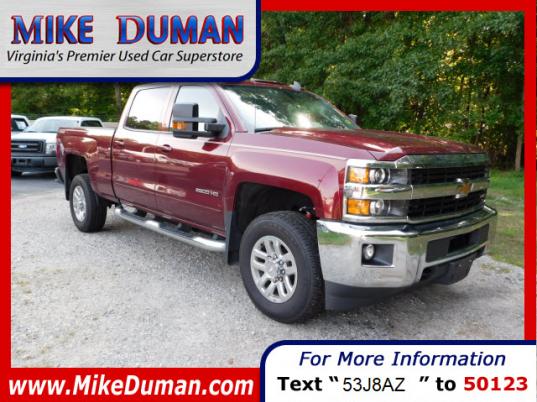
In the past, the numbers that appeared on trucks were associated most often with the tonnage. However, did you know those numbers also stand for things other than that? Over the years we have associated the numbers on a truck with the tonnage it can haul, but cargo is not the only thing that sets the Chevrolet Silverado line of trucks apart. Chevrolet makes three Silverado trucks, , 2500, and the 3500 which can also be categorized as a half-ton, three-quarter ton, and one-ton trucks. Even though all three of the Silverado’s are technically considered the same model, let's look at what makes them different.
 The Chevrolet Silverado 1500 is what’s known as a half-ton truck and weighs a total of five thousand three hundred and fifty-nine pounds. This truck is used more as a daily driver with room plenty of room for weekend projects. The
The Chevrolet Silverado 1500 is what’s known as a half-ton truck and weighs a total of five thousand three hundred and fifty-nine pounds. This truck is used more as a daily driver with room plenty of room for weekend projects. The  Silverado 1500 comes in several configurations as well as fifty-six trim options. The two-door regular cab can seat three people and can be paired with a six and a half-foot standard bed or the eight-foot bed; the four-door extended cab can seat as many as six people and can be matched with the standard bed. The crew cab also seats six and comes with the usual bed or a shorter five-foot bed. While it is smallest of the Silverado trucks, the 1500 can still haul up to seven-thousand pounds behind it with an extra one-thousand, seven-hundred and ten pounds in the bed. This comes in well under the other Silverado’s, however, what makes up for the lower tonnage is the gas mileage. The 1500’s estimated miles per gallon come in at seventeen city miles, and twenty-two highway miles per gallon; not bad considering this truck has the smallest fuel capacity of all the Silverado trucks with only a twenty-six-gallon tank
Silverado 1500 comes in several configurations as well as fifty-six trim options. The two-door regular cab can seat three people and can be paired with a six and a half-foot standard bed or the eight-foot bed; the four-door extended cab can seat as many as six people and can be matched with the standard bed. The crew cab also seats six and comes with the usual bed or a shorter five-foot bed. While it is smallest of the Silverado trucks, the 1500 can still haul up to seven-thousand pounds behind it with an extra one-thousand, seven-hundred and ten pounds in the bed. This comes in well under the other Silverado’s, however, what makes up for the lower tonnage is the gas mileage. The 1500’s estimated miles per gallon come in at seventeen city miles, and twenty-two highway miles per gallon; not bad considering this truck has the smallest fuel capacity of all the Silverado trucks with only a twenty-six-gallon tank
 The next weight class is the three-quarter-ton Chevrolet Silverado 2500 coming in weighing six-thousand, six-hundred, and twenty-five pounds. While there are eighty-four trim options available,
The next weight class is the three-quarter-ton Chevrolet Silverado 2500 coming in weighing six-thousand, six-hundred, and twenty-five pounds. While there are eighty-four trim options available,  there are fewer configuration options in the 2500. The two-door regular cab is only available with an eight-foot bed. However, the double-cab and crew-cab body styles can be paired with the standard bed or the more extended eight-foot bed. Compared to the 1500 this truck is a significant step-up on several levels, starting with a more substantial fuel capacity. The Silverado 2500 has a fuel capacity of thirty- six gallons, but even though it has a larger tank, the 2500 falls short from its younger sibling, the 1500, with its gas mileage. The sacrificed of fuel efficiency is made up for with its power. The 2500 jumps up to a V8 engine boasting a much higher horsepower and torque which can go from zero to sixty in 7.5 seconds.
there are fewer configuration options in the 2500. The two-door regular cab is only available with an eight-foot bed. However, the double-cab and crew-cab body styles can be paired with the standard bed or the more extended eight-foot bed. Compared to the 1500 this truck is a significant step-up on several levels, starting with a more substantial fuel capacity. The Silverado 2500 has a fuel capacity of thirty- six gallons, but even though it has a larger tank, the 2500 falls short from its younger sibling, the 1500, with its gas mileage. The sacrificed of fuel efficiency is made up for with its power. The 2500 jumps up to a V8 engine boasting a much higher horsepower and torque which can go from zero to sixty in 7.5 seconds.
 Bringing up the rear is the most prominent truck in Chevy's fleet, the Chevrolet Silverado 3500.
Bringing up the rear is the most prominent truck in Chevy's fleet, the Chevrolet Silverado 3500. The big brother of the Silverado’s doesn't have as many differences from the twenty-five hundred as you would expect. The 3500 has the same fuel capacity as the 2500 and only slightly less estimated miles per gallon. When it comes to power, this truck still holds its own, even though this truck can haul drastically more, the 3500 has the same power as the 2500 down to the number. Though the regular and double cabs can only be purchased with the eight-foot bed, the crew cab can be bought with either the six and a half-foot bed or the extended eight-foot bed. As the largest and heaviest of the Silverado line, the 3500 is all about payload. The payload in the 3500 is whopping four-thousand six hundred and eighty pounds, making this the most heavy-duty truck of the three Silverado models.
The big brother of the Silverado’s doesn't have as many differences from the twenty-five hundred as you would expect. The 3500 has the same fuel capacity as the 2500 and only slightly less estimated miles per gallon. When it comes to power, this truck still holds its own, even though this truck can haul drastically more, the 3500 has the same power as the 2500 down to the number. Though the regular and double cabs can only be purchased with the eight-foot bed, the crew cab can be bought with either the six and a half-foot bed or the extended eight-foot bed. As the largest and heaviest of the Silverado line, the 3500 is all about payload. The payload in the 3500 is whopping four-thousand six hundred and eighty pounds, making this the most heavy-duty truck of the three Silverado models.
Still not sure what number suits you? Come down to Mike Duman Auto Superstore today and decide for yourself which model is right truck!

*Inventory shown were available at the time this article was written but are subject to sale as our inventory changes often. Visit www.mikeduman.com to see our full range Chevrolet trucks and other vehicles that are available now!
